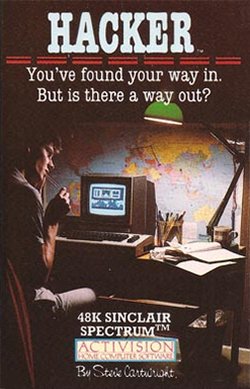Hacker (video game)
| Hacker | |
|---|---|

ZX Spectrum cover art for Hacker
|
|
| Developer(s) | Activision |
| Publisher(s) | Activision |
| Producer(s) | Brad Fregger |
| Designer(s) | Steve Cartwright |
| Engine | Custom |
| Platform(s) | Amiga, Amstrad CPC, Apple II, Atari XL/XE, Atari ST, Commodore 64, PC (MS-DOS), Macintosh, MSX, ZX Spectrum |
| Release date(s) | 1985, 1986, 1988 |
| Genre(s) | Puzzle/Strategy |
| Mode(s) | Single player |
Hacker is a 1985 computer game by Activision. It was designed by Steve Cartwright, produced by Brad Fregger and was released for the Amiga, Amstrad CPC, Apple II, Atari XL/XE, Atari ST, Commodore 64, Macintosh, MS-DOS, MSX and ZX Spectrum. The game was released two years after the release of the film WarGames, when computer hacking and computer security were in the limelight.
Activision executive Jim Levy introduced Hacker to reporters by pretending that something had gone wrong during his attempt to connect on line to company headquarters to demonstrate a new game. After several attempts he logged into a mysterious non-Activision computer, before explaining "That, ladies and gentlemen, is the game". The player assumes the role of a hacker, a person experienced in breaking into secure computer systems, who accidentally acquires access to a non-public system. The game was shipped with no information on how to play, thus building the concept that the player did hack into a system.
The player must attempt to hack into the Magma Ltd. computer system at the beginning of the game by guessing the logon password. Access can be gained if the player knows the password, which really only ever becomes apparent to the player after gaining access, through another means of entry, to the later stage of the game. Typing help or h in the command line would give a clue as to what the valid password is. Since initial attempts at entry would consist of guessing (and likely failing), access would eventually be granted to the player due to a malfunction in the security system. Once admittance has been made, the player is then asked to identify various parts of a robot unit, by pointing the cursor at the relevant parts and pressing the fire button. Most parts of the unit have exotic and technical names, such as "asynchronous data compactor" or "phlamson joint"—this again allows more room for error by initially trying to guess which part each name belongs to. Failure to identify each part correctly forces the player to take a retest until a 100 percent identification is made, at which point the player is then allowed to continue.
...
Wikipedia
